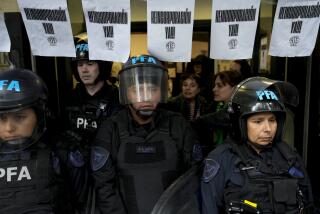Pretend Economy Fueling Argentina
BUENOS AIRES — These days, Horacio Costantino spends his days impersonating the successful businessman he used to be. He picks up the phone at his marine hardware store and makes calls all day--to his wife and mother, because his clients have long since disappeared.
He leafs through his ledger book and glances again and again at the only sale he’s recorded since November, for a mere $140. He calls the bank to find out if a check he deposited two months ago has cleared yet. It hasn’t.
“I went to the bank to withdraw some dollars,” the 41-year-old says. “They told me they were allowed to give them to me but they didn’t have any.”
Such is life in Argentina, a country living in an Alice-in-Wonderland economy of banks without cash, where no one is exactly certain what the real value of the local currency will be next week and where getting your hands on any money at all is a test of endurance and wit.
Argentina’s economic crisis has worked its way like a bad cold through the streets of La Boca, a working-class district on the southern edge of Buenos Aires famous for its colorful houses and successful soccer team.
Like other parts of Argentina, La Boca is running on a phantom economy as the country’s politicians work feverishly to develop a recovery program for this nation, burdened by high unemployment and a $135-billion public debt.
La Boca copes by little acts of “solidarity” among businesspeople, family members and friends. At a collection of kiosks catering to tourists, merchants share lunches and pay the bus fare home for those who go a day without making any sales.
Those who do have customers sell their goods at prices that are floating gradually upward, following the recent devaluation of the peso by nearly 30%, from parity to 1.4 to the dollar. Soon, the peso will also float on the open market. With the peso suddenly worth less, the prices of staples such as bread have already increased by about 30%.
On Sunday, the government said the devaluation would take effect within 72 hours. But on Tuesday, officials said they would postpone the move. A partial banking holiday will remain in force, including a freeze on many transactions involving foreign currencies.
The peso is already trading at a widely fluctuating rate on the black market here, with some traders selling dollars for as much as 1.8 pesos. Some economists have said the peso’s value may drop to as low as 2.7 to the dollar by the end of the year.
“I’m totally confused,” Sonia Villavicencio, 29, says as she sits behind the counter of her kiosk in La Boca, offering Argentine knickknacks to the sparse crowd of tourists.
With the true value of the peso still in doubt, Villavicencio has decided to place new stickers on all her goods listing the price in dollars. Unfortunately, she’s discovered that most people who pay with the U.S. currency expect a big markdown that she can’t afford.
“My business isn’t on solid ground right now,” she says. Her suppliers won’t give her a fixed price for the T-shirts, guitars and wood-carved mate cups she sells. One day recently, her sales totaled $20. Another day, she sold even less and was forced to ask her neighbors for bus fare home.
“Thanks be to God for my friends,” she says.
Argentines have been living under a growing sense of doom for some time now as the country has suffered through a four-year recession and a fiscal crisis that has forced federal and local governments to slash budgets and lay off thousands of employees.
The federal government also has placed strict limits on bank withdrawals, leaving consumers with less cash to spend. Those with dollars--which were widely used here during the last decade--are hoarding them until the devaluation sinks in. All those factors have contributed to a situation in which very little cash is circulating on the streets.
“You have to take anything now,” Dora Nieves, 81, says after a customer pays for some produce with a patacon, a currency issued by a neighboring province struggling to pay its debts.
Without bothering to hide her disgust, she takes the one patacon bill and places it in the register with similar notes.
Nieves’ employee, 53-year-old Roberto Benitez, says he just asked his boss for a raise to cover the rising costs of utilities and staples.
“What I make isn’t enough to live on,” he says. His 500-peso monthly salary is now eclipsed by 800-peso living expenses. When his boss turned down his request for a raise, there was nothing he could do. Unemployment stands at 18% here.
“I’m going to have to take what little I have, because if I quit I’ll suffer even more,” he says.
Business transactions of all kinds have been thrown for a loop by the economic crisis and the uncertainty of the last month, which has seen riots, protests and five different men as president.
Marcelo Pache, a lawyer, says his clients owe him $2,500 in unpaid bills for handling their divorces, wills and other matters of family law. The middle of the workday finds him on a street corner in La Boca, passing out fliers for a restaurant offering a “lunch with tango” show.
“I’m just trying to help out the owner, who’s my friend,” he says.
Back at Costantino & Son, the marine hardware store, Horacio Costantino doesn’t need much help. He’s contemplating taking everything he owns, selling it off and heading north for the United States, shutting down for good the business his father founded.
The $140 he last took in didn’t even cover his phone bill. He lives now, like many others, by spending his savings.
He looks out at a shop filled with chains, heavy-duty grappling hooks, anchors and other goods. “It took 40 years of work to build this,” he says, “and now it’s being lost.”
(BEGIN TEXT OF INFOBOX / INFOGRAPHIC)
Rising Prices in Argentina
Prices are rising in Argentina on everything from bread to electronics, as shortages and the upcoming devaluation of the peso drive inflation. Spot checks show:
Last week This week
2.2 pounds of sugar 45 centavos 59 centavos
2.2 pounds of bread 1.6 pesos 1.8 pesos
29-inch color television 1,399 pesos 2,189 pesos
2.2 pounds of Yerba mate (herb used for national drink) 1.9 pesos 2.3 pesos
Package of 18 disposable diapers 4.9 pesos 5.9 pesos
Note: For 10 years, the government set the value of the peso at 1 per U.S. dollar. The official rate is to be 1.4 pesos per dollar, but the black market rate is fluctuating widely.
More to Read
Sign up for Essential California
The most important California stories and recommendations in your inbox every morning.
You may occasionally receive promotional content from the Los Angeles Times.











